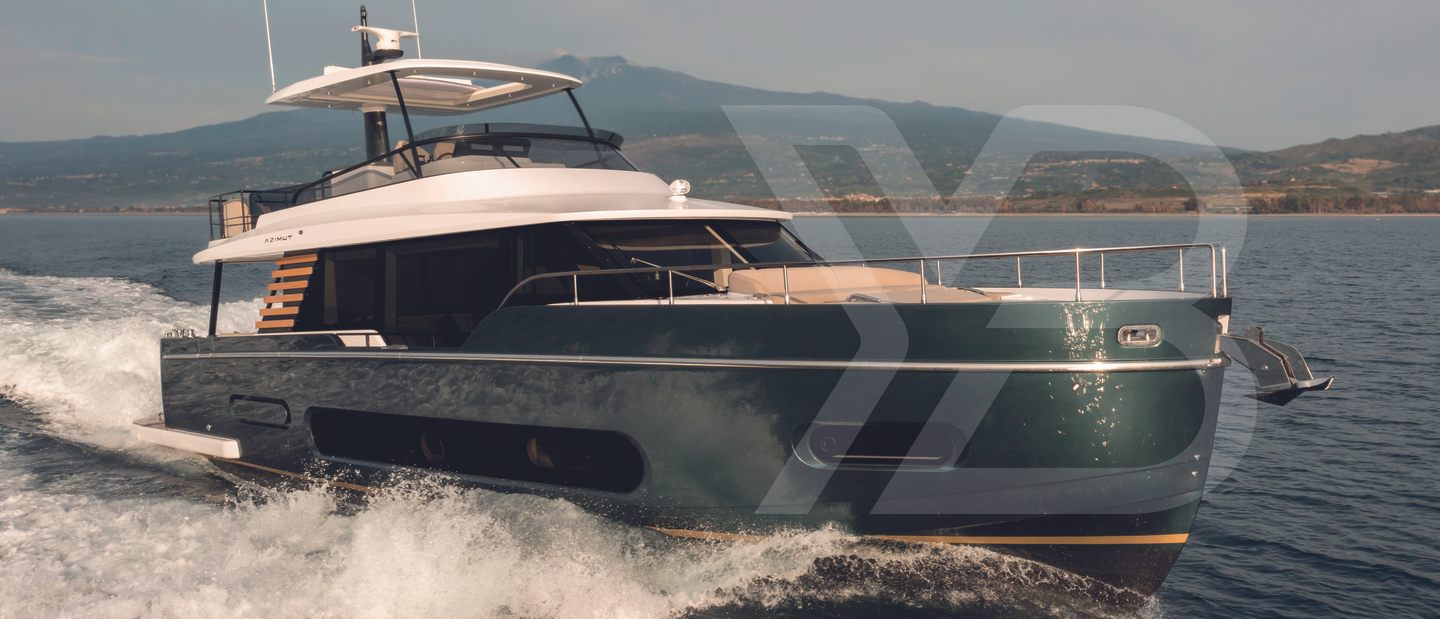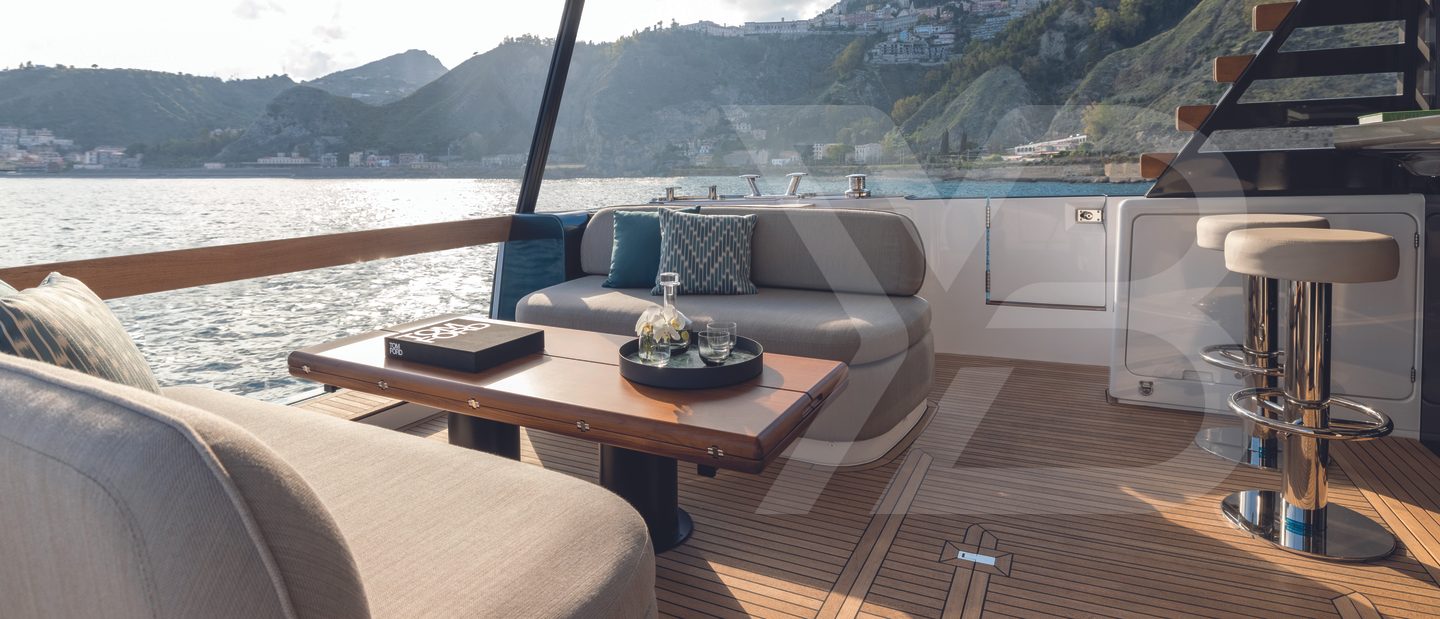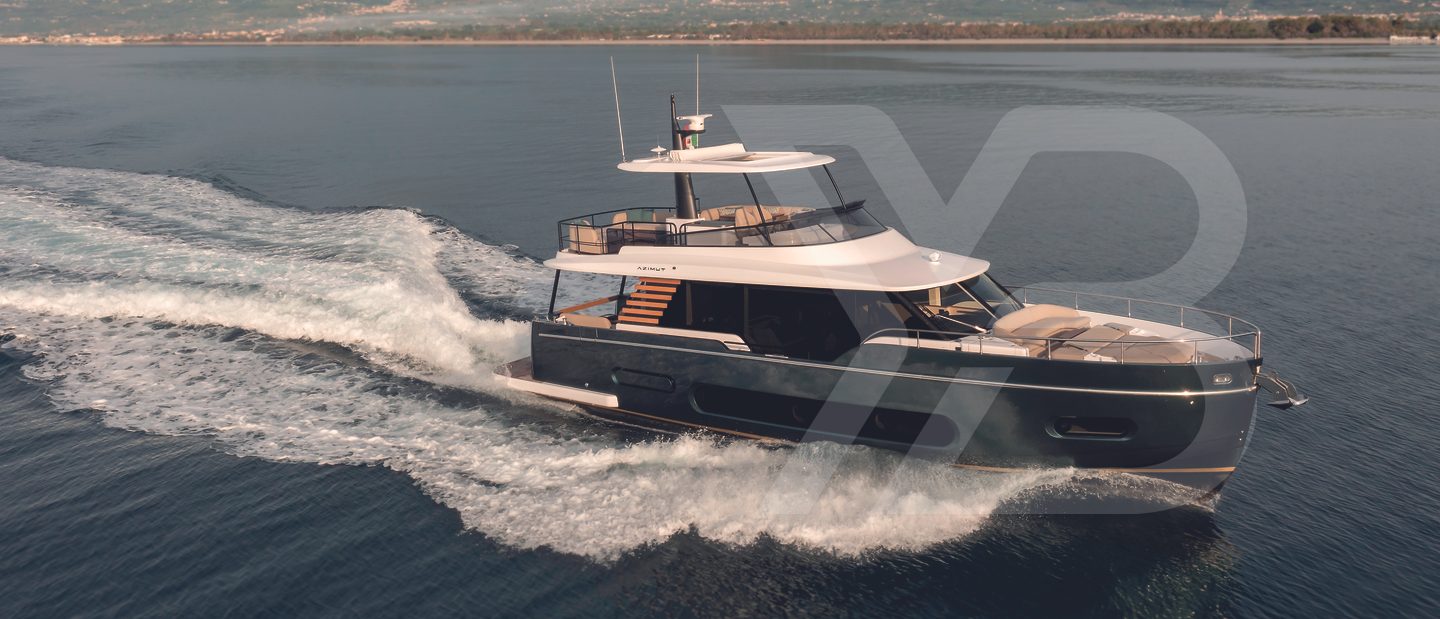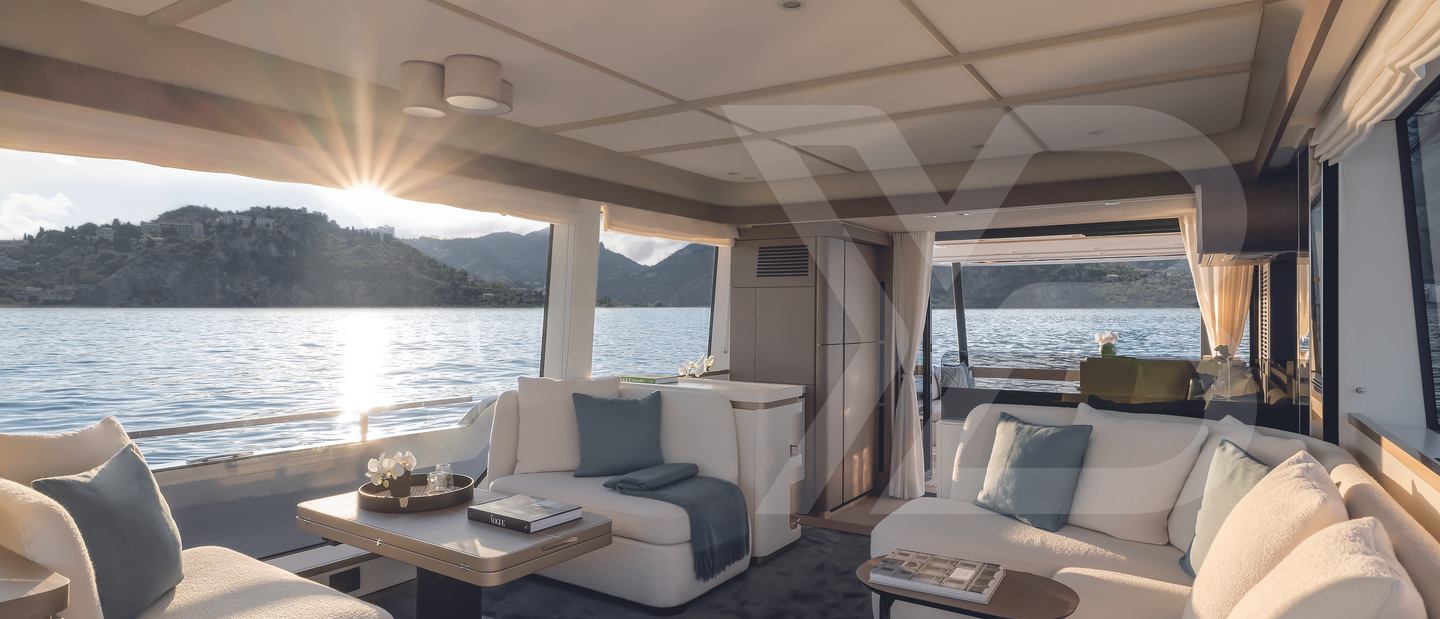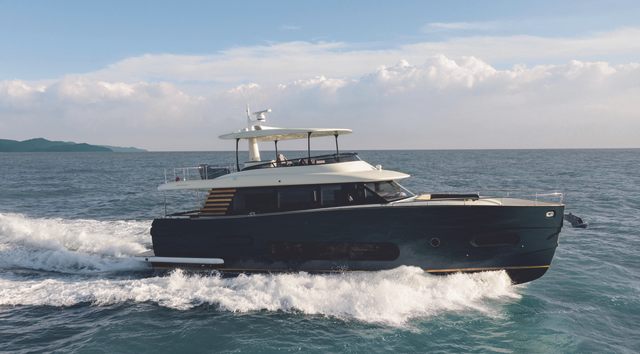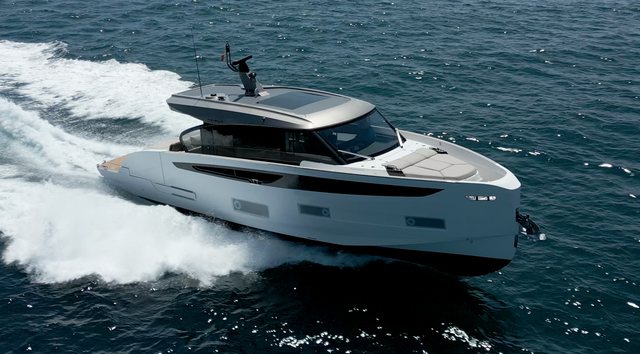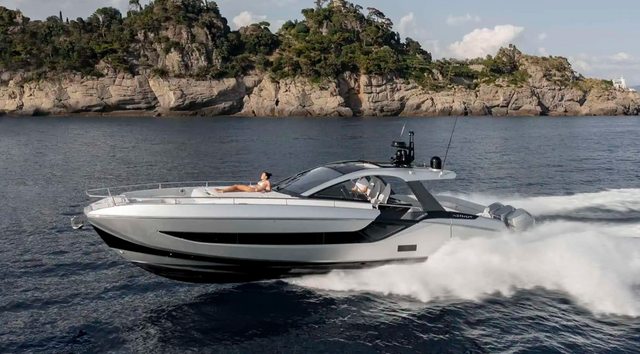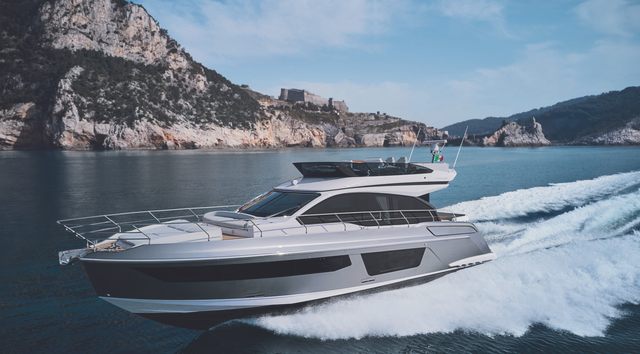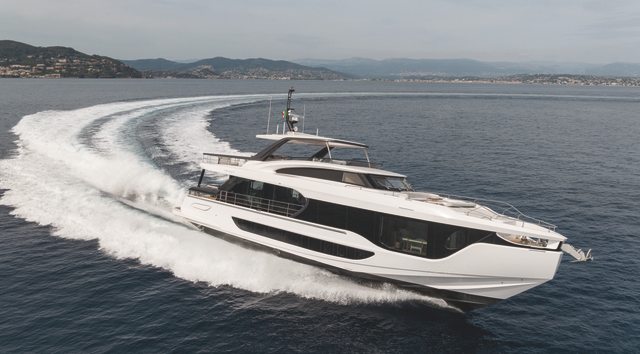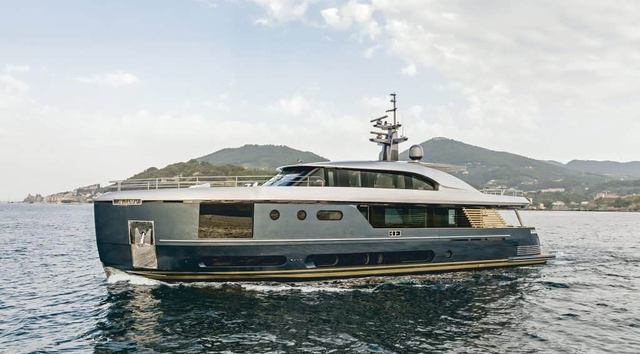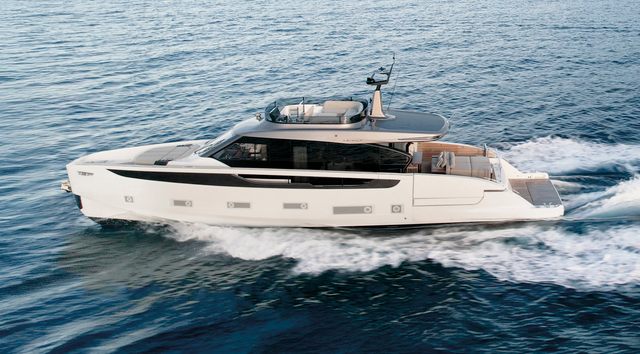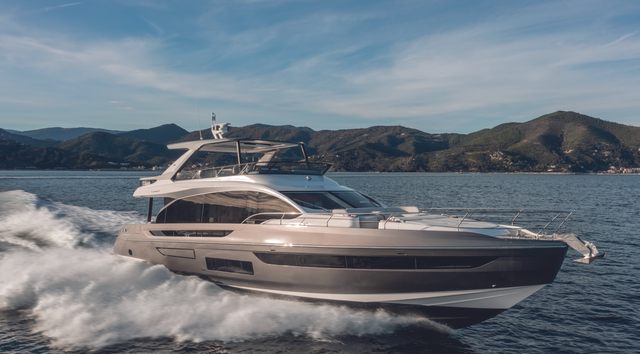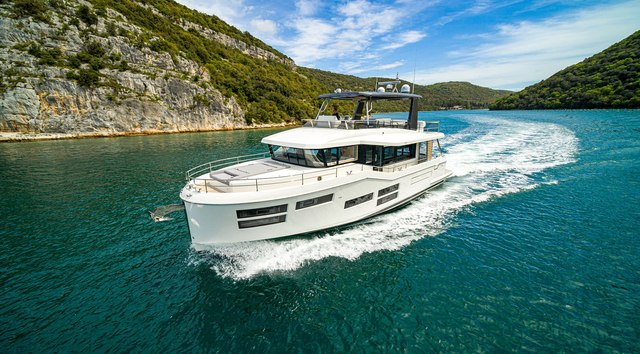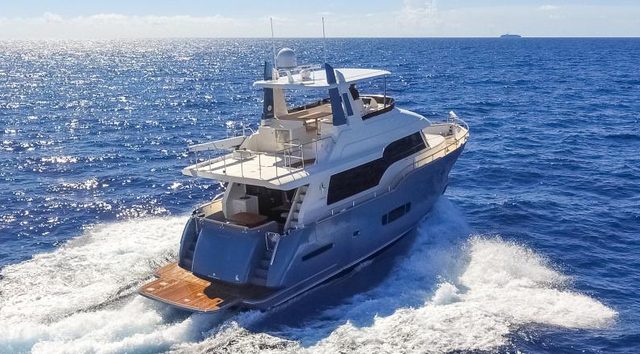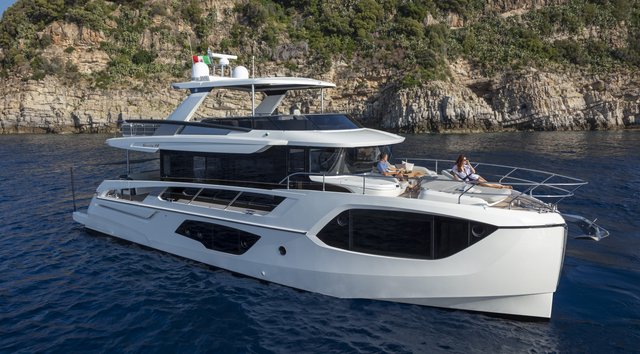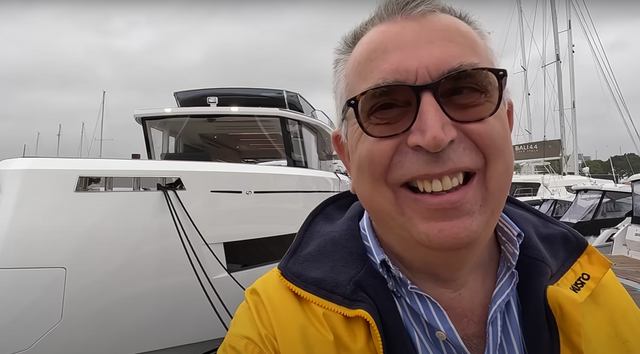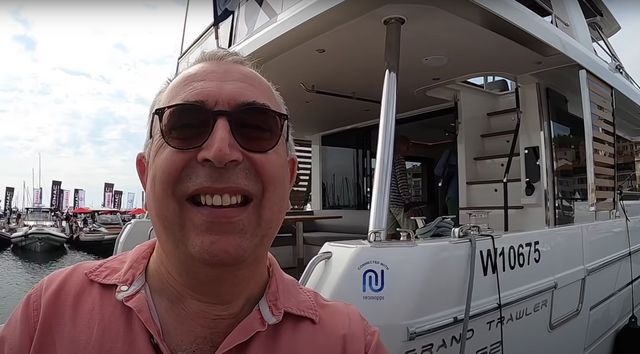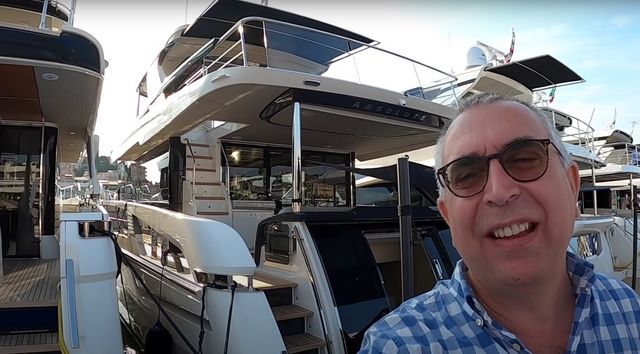The Azimut Magellano 60 is the newest and smallest model in Azimut Benetti Group’s stylish pseudo-Trawler range. As with its larger siblings, the 60 has styling by superyacht designer Ken Freivokh and a semi-planing dual-mode hull, designed to be stable and efficient at slower speeds but capable of over 25 knots flat out.
On board, there are three cabins and three bathrooms with an aft galley layout on the main deck and a flybridge characterised by the distinctive central radar mast. In the cockpit, the facing seating creates a more sociable arrangement, bolstered by the glass transom, designed to make a terrace overlooking the bathing platform. There's a lot to enjoy about this design, keep reading to discover what the 60 is like on the water, how much it costs and how it compares to its rivals.
Test & Review Video
Around the Marina
Though the Magellano 60 is quite a high-sided boat its relatively large keel section keeps it solidly planted at slow speeds and when manoeuvring. As standard, the boat comes with a joystick, which works both MAN engines and the proportional bow thruster to shove the boat in the required direction. It's a relatively smooth and effective system, though like many of its kind, doesn't have the quick reaction times of a pod drive boat, so experienced hands may prefer to use the throttles and thrusters independently.
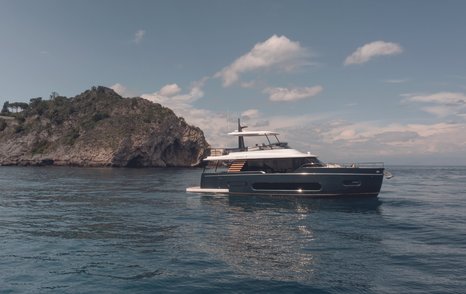

The view is good from both main helms but there is the option to have a third docking station in the cockpit, which those often faced with stern-to berthing will likely appreciate.
The trawler-inspired design is inherently good for the crew. Side decks are spacious and well-protected, deck storage is ample and it's a boat that feels safe to move around on. With no railings running amidships to the stern you have to use fender straps towards the aft end of the boat, which slows things down a bit, but it's a technique you soon get used to.
At Sea
There is only one engine option on offer; twin 12.4-litre MAN i6 diesels with 730hp per side. The Magellano 60 runs on a "dual mode" (Azimut speak for semi-displacement) hull for a top speed of 26 knots and a flexible cruise of between 8 and 20 knots. Its "fast" cruising speed is 18 knots and you can expect a pretty impressive range of around 350nm. Slow it back to 8 knots and a relaxed 1,000rpm and that range shoots up to a whisker under 1,000nm. Good going for a leisure-focused 60-footer.
The MAN i6s are well-proven engines and they provide plentiful grunt without ever sounding like they're working too hard. The dual-mode hull eases between full displacement and semi-planing with no discernible transition, which makes it easy to pick a cruising speed that is most suited to the conditions. It was lumpy on our test day and aside from a touch of the semi-displacement wallow - much of which was ironed out by the Seakeeper gyro - the Magellano handled it well.
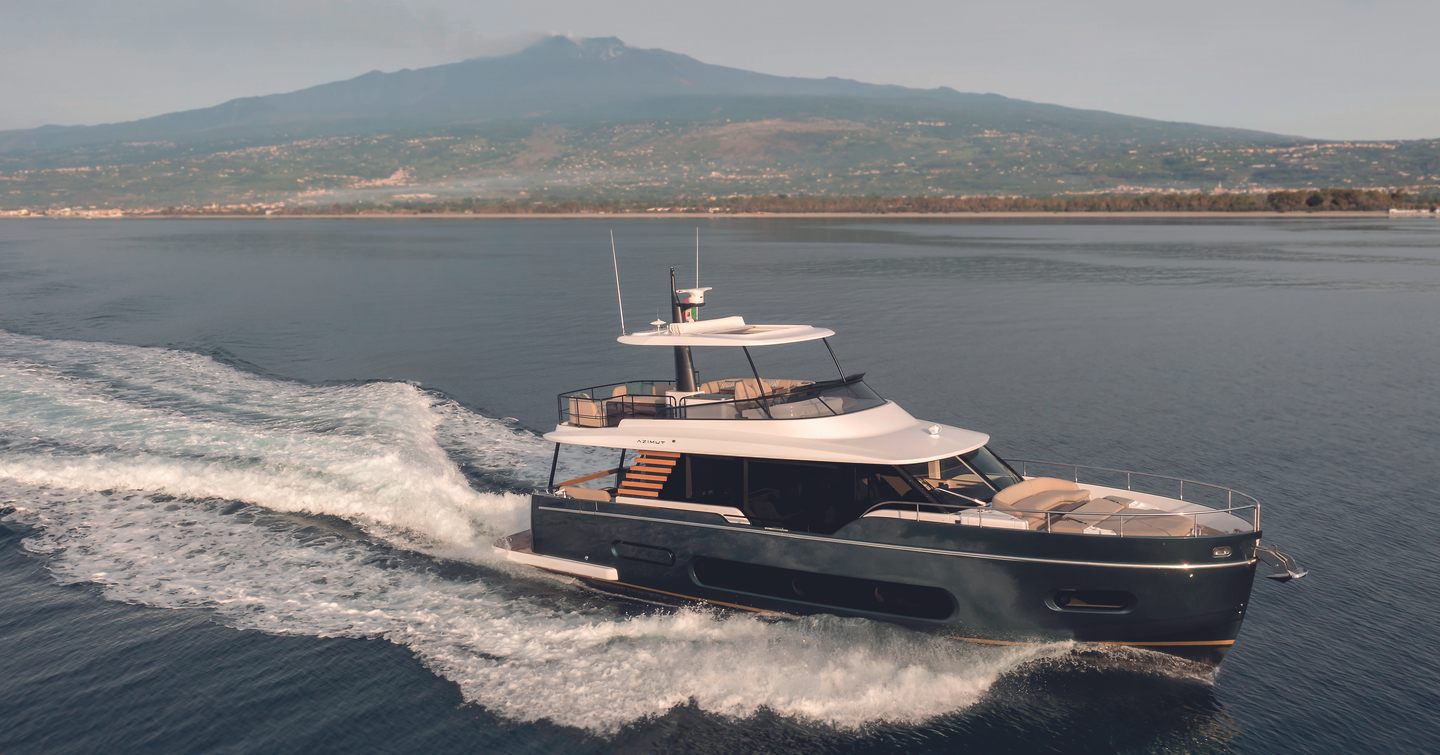


The fly-by-wire steering is light but this gives the boat a poise and agility that you might not expect from a craft with this type of hull form and it means that hand steering is easy in a seaway. That said, it's best to let the hull find its way through the waves and leave the wheel alone. The light steering, as good as it is, means you can sometimes overcorrect in reaction to the wave pattern which makes the ride less comfortable. Hold a line, set the speed and the hull will do the work for you.
The bow isn't particularly flared and it's relatively upright but the spray rails do their job and deflect water away from the boat so it doesn't come showering over the deck. The ride is smooth and comfortable but you don't feel totally detached from the driving experience like you do with some semi-displacement cruisers.
It's quiet, too. At the lower helm, we registered 68 decibels at an 18-knot cruise, impressive considering it was far from a flat calm day and the sort of conditions that can often unearth slams from the hull and creaks and groans from the interior. Not here. The noisiest thing on board was the cutlery rattling around inside the galley draws.
Azimut often works with designers from outside the organization and much of the Magelleno line was created in conjunction with superyacht designer Ken Freivokh. The Magellanos are great-looking yachts in our opinion but the 60 might just be the sweetest in the range. It's muscular and modern but there are nods to traditional trawler design and some fabulous detailing. The wooden slats on either side of the wheelhouse, for example, and the black powder-coated railings and windscreen surround on the flybridge that blend into their surroundings and help to reduce the visual height of the boat. How about that green hull color, too? There aren't enough green boats in our opinion.
The central mast on the flybridge is a Magellano trademark and though it gives the 60 its distinctive profile it's functional too. The aft end of the hard top is mounted to it, it incorporates an overhead shower and, of course, it's home to the navigation equipment.



Another Magellano trait is the facing sofas in the cockpit and though we're seeing this design feature more and more these days it still stands out as a great design decision on the 60. The glass transom, deep sofas, and large expanding table create a fab alfresco dining space; more on that later.
The interior, designed in-house by Azimut, is more restrained than some recent models, and all the better for it. It still has playful touches and feels very different from its close competitors but it's much less controversial and treads the line well between form and function. If you want something more vibrant and colorful than the monotone palettes you'll find elsewhere then the Magellano 60 delivers.
The engineering is good, too, and the hull, structure, and interior certainly felt robust as we powered through the lumps on sea trial. There isn't standing room for someone of 6ft (1.83m) in the engine room but the installation is sound and there is easy access through a hatch in the cockpit floor.
As alluded to above, the interior is more toned down than we have come to expect from Azimut but it still delights with its individualism and adventure. It's not just the décor, the layout is interesting, too, especially the adjustable dinette on the starboard side. This area somewhat mirrors the cockpit arrangement and it feels more sociable to have opposing seating as opposed to the L or U-shaped dinettes you'd expect to see on a boat of this style. It lines up with the starboard saloon window, too, so the views are great. The downside is that there is only space to sit four people but this will likely work for the majority of owners.
The galley is aft and it's noticeable how well concealed everything is when it's not in use. The appliances such as the dishwasher are covered with laminate fascias and there are lots of lids set into the counter over the sink and storage bins to extend the working space. There's nowhere obvious to put these lids when they're not in place, however, which is annoying. The domestic fridge/freezer unit is on the opposite side of the saloon to the galley and is discreetly integrated between timber paneling as well. It's a functional space that doesn't encroach more than it should.
Detailing is lovely. The Alpi wood finish is fixed but there's variety in the color options of things like the carpet, sofa cushions and other soft furnishings. The use of uplit ratan inside some of the storage voids works well, the lighting fixture above the dinette and the TV that pops up from the unit opposite the galley swivels so that it can face different parts of the saloon or into the cockpit. There is easily accessed storage beneath the sofa on the port side, too.



Accommodation
The interior design pops to the fore on the lower deck where there are cabins with real character but, again, as with the main deck, it's not overdone or in your face. The layout is interesting, too. Right forward in the bow is the VIP ensuite with a double bed mounted in the usual position and an ensuite that also has access from the main lobby for the twin cabin on the starboard side. Those long windows that are subtly integrated into the hull sides do great things here by drawing in masses of natural light to somewhat compensate for the lack of a skylight.
Despite the door leading off from the lobby into the VIP ensuite, there is a proper day head on the lower deck, positioned further amidships just forward of the owner's cabin. It's slightly oddly positioned given its distance from the twin cabin whose occupants will need it most but it means those in the VIP can lock the lobby door to their bathroom for the inside for some privacy, safe in the knowledge that they won't be denying those in the twin access to a bathroom. All three bathrooms are tastefully finished with black sinks set inside marble effect tops, sprinkles of teak in the shower stalls, and attractive black fixings.
It all comes together in the owner's cabin, which sparkles with eye-catching design touches from the choice of materials to the pebble smooth door handles, the TV, which hides inside a mirror, and the thoughtful mix of lighting. It's a genuinely lovely space that offers something so fresh and different compared to most of this boat's rivals. Given the cabin stretches the full beam of the boat there's plenty of space and headroom throughout the interior is comfortably over 6ft (1.83m).
Something that really adds to the feeling of luxury in this area, though, is the size of the ensuite. It's huge for a boat of this size and is finished to such a high standard. It's a standout feature, which isn't something we say about many ensuite bathrooms.



Crew Accommodation
The crew space is accessed via an upright door on the transom, which you can still open easily with the tender in place on the hydraulic bathing platform. Many owners won't feel the need to have a crew on a boat of this size but the single berth and wet room are okay for short stints and, actually, quite a useful extra occasional berth, especially for a teenager.
The upper helm is a long way forward on the flybridge and it's protected by a deep windscreen with an angled lip, designed to drive the oncoming breeze over the skipper's head.
The helm station itself isn't all that exciting to look at with a trio of MFDs set into black facias, which at least ensures there isn't much glare pinging of the dashboard. Most functions are controlled through the twin Raymarine MFDs and the MAN engine screen but there is a neat panel of backlit switches to control things like the horn, navigation lights and anchor. The Raymarine screens are touch screens but there is a remote aft of the throttles so they can both be controlled without having to stretch out of the helm chair.
The driving position is good with adjustable seats and a large steering wheel, which despite being fixed falls to hand easily. It would be better to move the autopilot screen onto the main dash so that the throttles can be positioned closer to the helm seat but, that aside, there's little to complain about up top.


Lower Helm
It's always good to be able to stand and drive a boat from its lower helm and it's easy to do so on the Magellano 60. There isn't a huge amount of space between the wheel and the seat but there's enough if you do want to stand at the helm and, when seated, the fully adjustable leather seats have enough movement to ensure that most skippers will be able to get comfortable, even if the backrests are a little low.
The dash itself is similar in design to the one upstairs, though everything is a little closer to the helm seats so ergonomically it's slightly better. In contrast to the upper helm, the navigator is trapped by the skipper so the person driving will have to move to let their co-pilot in and out but the positive is the more central driving position has less of a blind spot on the starboard side.
The boat doesn't have a side door at the helm, something it lacks compared to some of its close rivals, but there is a sliding window that allows the skipper to talk to the crew if they're handling the boat from inside at slow speed. Most of the time, though, slow-speed work will likely be done from the flybridge or the optional third control station positioned in the cockpit.
Out back, the Magellano 60 has a hydraulic bathing platform as standard with a hefty 500kg weight capacity, meaning it's capable of launching and recovering a decent tender of around 3.3m (10.8ft), slightly longer if you don't have the passerelle fitted. There isn't a step between the platform and the main deck, though, so it can be a bit of a leap to clamber between the two when the platform is deployed. There are a couple of hatches set into the transom, one for the crew cabin and another horizontal one that reveals a usefully large storage locker, perfect for stowing mooring lines or wet kit.
In the cockpit, there is some more useful storage, including a dedicated space and charging point for a Seabob beneath the starboard side dinette lounger. The cockpit is such a big part of the 60's appeal. It's not the first time we've seen cockpit seating arranged this way but it's executed with such style here and creates a much more sociable and inviting living space. The rounded sofas are squishy and comfortable but supportive and at sea, the position closest to the transom feels like a waterside terrace - it's a great arrangement. The table adjusts at the touch of a button (as a cost option), too so it can drop down to coffee table level or rise to be used for dining.
Our test boat has a couple of bar stools arranged in the forward section of the cockpit, which line up with the drop-down window in the galley to create a bar area between the two spaces. We felt this feature worked well but if you don't think you'll use it or you need more storage there is the option to replace the bar stools with a low cupboard unit instead.



To The Fore
There are boarding gates on both sides of the boat just forward of the cockpit, which comes in handy when moored side-to a tall quay or at a fuel dock, for example. There are no guardrails towards the aft end of the deck but the bulwarks come up to a decent height and provide reasonable protection before the guardrails pop up at the bow.
The foredeck is a well-designed space. It features the now familiar sofa and sun pad arrangement but, much like the cockpit, it's executed with style. The simple but clever arrangement where the top edge of the sun pad flips up to create a three-person aft-facing sofa is a great touch, too. There are deep deck bins on either side and some shallower molded trays on either side of the sun pad to take care of glasses and loose items. It's practical but thoughtful and stylish.
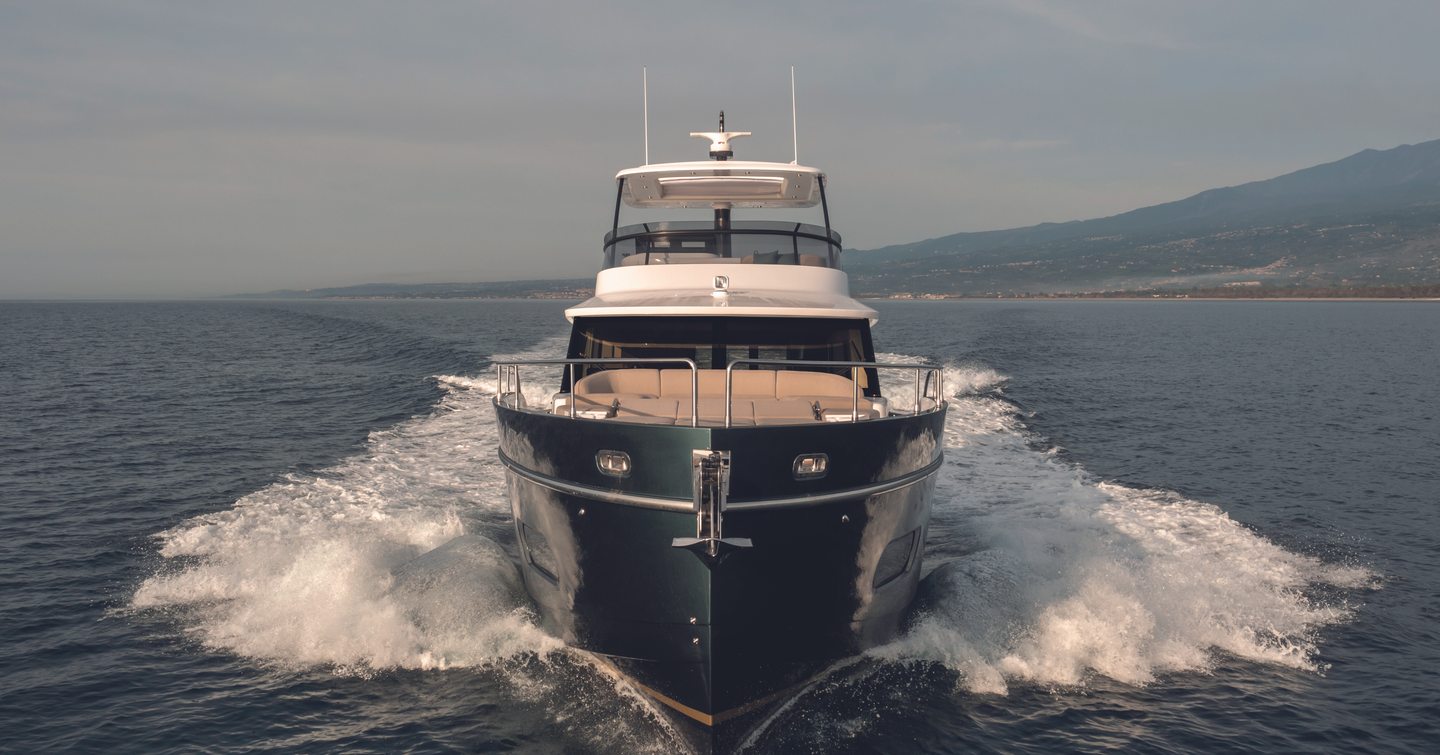
Take It To The Bridge
The flybridge is such a distinctive part of the Magellano's design and, like the other deck areas, effortlessly blends function and style. We mentioned the central mast above and it's a particularly striking feature that as well as giving the boat its unique look also supports the optional hard top with a sunroof (a bimini is standard) and is fitted with a proper overhead shower. We're not sure when you're actually going to use said shower but it's a nice option to have if you need to cool off.
Aft, there's a similar terrace feeling to the cockpit where comfortable seating edges up to the aft end of the deck with a great view out over the back of the boat. Between this area and the dinette amidships the wet bar is neatly tucked up against the radar mast so that it's well-positioned to serve both seating areas. There is a large step between the aft and forward sections of the deck, presumably to boost headroom in the saloon, which takes some getting used to. That aside, it's another well-designed area of the Magellano 60.
The base price for the Magellano 60 is €1,650,000 ex VAT (correct at the time of writing). Add a few extras and some tax and you'll likely be in the region €2,000,000 for an "on the water" package. Azimut's options list is extensive but there are some major items that we think most owners would benefit from.
Our Options & Pick
The cockpit docking station (€15,000) will be useful for those who berth stern to regularly and it includes proportional control of the thrusters and a joystick, which combines the engines and thrusters under one control. A joystick at the main helms is standard, remember. There are two Seakeeper options, the NG9 (€133,100) and NG13 (€199,350). We had the smaller one on our test boat and it managed reasonably well in a rolling swell but if you plan to spend a lot of time on anchor then the beefier NG18 might be worth the €65,000 extra.
The foredeck lounge arrangement is €22,850, which is no small chunk of change, but the convertible sun pad/sofa and adjustable teak table make a difference to the usability of the space, so it's worth it. In a similar vane, there are furniture options to add at the aft end of the flybridge, all of which are around €UR 30,000 and worth adding to extend the lounging space on the top deck.
The flybridge hard top is a €90,000 option. It includes a canvas sunroof but the bimini is almost half the price and nearly as practical. That said, with resale in mind the hard top is probably the safer option as many buyers will be looking out for it. That beautiful green-painted hull, transom, and gunwale is a €UR 50,000 option but it's such a big part of the boat's character it borders on necessity.
The hydraulic is standard (good), and the transom storage locker is a €20,000 option (bad). Come on Azimut, that sort of thing shouldn't be a cost option...
Co-pilot seats are options at both helms and cost around €5,000 each. We would have them but that is quite a personal choice and the extra floor space without them might be welcome.
Finally, there are three Raymarine packages on offer (Silver, Gold, and Platinum). Gold, at €30,000, probably covers what most people will need and it saves a good chunk over the Platinum upgrade.
Our Verdict
We’ve always had a soft spot for the Magellano range but the 60 stands out for several reasons. The exterior looks great and it’s a design where the more time you spend with it the more detail you pick up. It has real quayside appeal and that’s not something you can say about all modern trawlers. The arrangement of the deck spaces works well too and there’s an underlying practicality that makes the 60 usable and easy to live with. And the more toned-down interior works so much better than the whacky designs from Azimut of late, it’s fresh and interesting without being over the top. It’s an expensive boat with a hefty cost option list but we reckon it might be the best Magellano you can buy.
Reasons to Buy
- Stylish design
- Excellent deck spaces
- Flexible cruising performance
- Attractive interior
Things to Consider
- No side door at the helm
- Engine room space
- Some options are expensive
Looking to own a Azimut Magellano 60? Use YachtBuyer’s Market Watch to compare all new and used Azimut Magellano 60 Yachts for sale worldwide. You can also order a new Azimut Magellano 60, customized to your exact specifications, with options for engine choice and layout configuration. Alternatively, explore our global listings of new and used yachts for sale and find your perfect yacht today!
Rivals to Consider
The Magellano 60 is a pretty unique proposition in the 60ft sector but there are few other "soft trawlers" on the market that offer stiff competition.
The Sirena 58 is available with or without a flybridge and the Turkish-built yacht offers tip-top engineering with impressive interior volume for its length. Its interior decor is more plain than the Azimut's but it has greater flexibility in terms of lower deck accommodation. Three cabins and three bathrooms are the standard configuration with the owner's cabin amidships but you can have the owner forward with a pair of twins amidships or a very spacious two-cabin, two-bathroom layout. Caterpillar engines with either 640hp or 840hp per side provide punchy performance for a top speed of over 30 knots.
The Pardo E60 is quite a different concept to the Magellano 60 but it offers similar performance and runs on Volvo Penta IPS pods, which may appeal to those who like the idea of joystick control. It too has a three-cabin layout with a reasonable crew space and though its flybridge isn't as big its standard fit drop balconies in the large cockpit make up for this. It's a striking design, too, and that reverse sheer bow fronts a hull that is impressively robust through the waves.
The Absolute Navetta 58 is another IPS boat that could be considered alongside the Azimut, even though it's a touch smaller. You'd never know from the inside, though, the amount of interior volume is exceptional for its size. It has a three-cabin arrangement with the owner amidships but the offset VIP is an Absolute trait which cleverly leverages the most out of the available space up front. It also has sliding berths in the twin cabin for added versatility. If crew is a consideration then the two-berth crew space on the 58 is about as good as it gets amongst its peers. It doesn't have the charm of the Azimut but it's a lot of boat for the money.
We mustn't forget the French because Beneteau Group has a couple of boats in this sector and though they're quite different to the Azimut they ought to be considered if you like this type of craft. The Beneteau Grand Trawler 62 is the flagship of the Beneteau Power range and it's much more of a traditional trawler in its design ethos. It's spacious, incredibly practical and bursting with storage so if liveaboard cruising is on the agenda it's well worth a look. It's built to a price but offers serious bang for your buck. The Prestige X60 on the other hand is much more in tune with the Azimut. Its interior is dripping with style and there's some brilliant design flair on board. It's a little awkward looking but it's a much classier aesthetic for Prestige and it offers impressive value for money.
Considering a new yacht? Explore Azimut's entire current range to find the model that best suits your needs, and compare it with alternatives from competitors to ensure you make the perfect choice.
Specifications & Performance
- Builder Azimut
- Range Magellano
- Model Magellano 60
- Length Overall 18.47m
- Beam 5.15m
- Draft 1.37m
- Hull GRP
- Cabins 3
- Berths 4
- Crew 1
- Cruising Speed
- Max Speed
- Fuel Capacity 3,650 Litres
- Fresh Water Capacity 750 Litres
- Engine Model 2x MAN i6-730
- Engine economic speed 8.5 knots
- Engine max range (speed type) 827 (nm)
Performance Data
Azimut Magellano 60 version 2023. *Data supplied by the manufacturer.
Test Engines Twin MAN i6-730
- RPM
- Knots
- Liters Per Hour
- Liters Per Mile
- Range (nm)
- Decibels
-
- ECO
- 1,000
- 8.2
- 30
- 1
- 998
- -
-
- 1,200
- 9.9
- 50
- 5
- 722
- -
-
- 1,400
- 11.2
- 80
- 7
- 511
- -
-
- 1,600
- 13.0
- 118
- 9
- 402
- -
-
- 1,800
- 16.3
- 170
- 10
- 350
- -
-
- CRUISE
- 2,000
- 20.1
- 200
- 10
- 365
- -
-
- 2,200
- 23.5
- 250
- 11
- 343
- -
-
- MAX
- 2,350
- 26.0
- 310
- 12
- 306
- -
Interested in a Magellano 60?
NEW Build
Find your local dealer for a personalised, no-cost consultation
or just request
Brochures & Pricing
Used & In Stock
Looking for a ready-to-go Magellano 60 or pre-owned options? Explore all inventory of the Magellano 60 available worldwide
